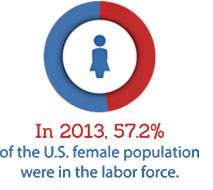Gender inequality: men and women performing the same tasks, but receiving unequal pay
 Despite women making up almost half of the U.S. workforce, a gender pay gap still exists. The Equal Pay Act (EPA) seeks to combat this continued pay disparity by trying to eliminate gender discrimination in the workplace. Employers need to be mindful of the Equal Pay Act, the Lilly Ledbetter Act, and other equal pay legislation that governs how employers pay their employees, especially when those employees perform similar tasks. Companies that fail to adapt to these laws are opening the doors to compliance and litigation that will result in back pay to the company’s employees and public relations issues that can hurt the company’s profitability and image.
Despite women making up almost half of the U.S. workforce, a gender pay gap still exists. The Equal Pay Act (EPA) seeks to combat this continued pay disparity by trying to eliminate gender discrimination in the workplace. Employers need to be mindful of the Equal Pay Act, the Lilly Ledbetter Act, and other equal pay legislation that governs how employers pay their employees, especially when those employees perform similar tasks. Companies that fail to adapt to these laws are opening the doors to compliance and litigation that will result in back pay to the company’s employees and public relations issues that can hurt the company’s profitability and image.
The equal pay act is one of many policies to close the gender wage gap
The EPA requires employers to pay men and women equally when they have equal responsibilities, workload, and experience. Basically, men and women should be paid equally when they have equal workloads. The EPA applies to all employers.
How to determine which of your employees should be paid equally
The EPA does not require for your employees’ jobs to be identical, just “substantially equal.” This is determined by job content and duties, rather than job title. Here are some criteria for evaluating whether a male and female employee are performing a “substantially equal” job:
- Performing work that requires relatively equal skill, effort, and responsibility
- Performing jobs under the same working conditions
- When the male and female employee work at the same establishment
If the employees at your company meet these three criteria, then they should be receiving equal pay.
What type of compensation is covered by the equal pay act?
Oftentimes, employers have to compensate their workers in various ways. However, the Equal Pay Act provides strict pay requirements for men and women performing substantially equal tasks. The EPA compensation rules include: salary pay, overtime pay, bonuses, stock options, profit sharing and bonus plans, life insurance, vacation and holiday pay, reimbursement for trial expenses, and benefits.
 Pay can differ between genders, as long as the difference is based on reasons other than the gender of the employee. For example, wage inequality can be the result of seniority, merit, an incentive system, or any other factor other than the employee’s gender. Employers cannot reduce the wage of either sex to make up for the difference.
Pay can differ between genders, as long as the difference is based on reasons other than the gender of the employee. For example, wage inequality can be the result of seniority, merit, an incentive system, or any other factor other than the employee’s gender. Employers cannot reduce the wage of either sex to make up for the difference.
Tips on how to comply with the equal pay act
The Equal Pay Act is one of the easier compliance regulations that employers can avoid. It all boils down to taking a little time to organize and group employees into specific pay brackets. Make sure that you keep in mind age, gender, and ethnicity when grouping employees, and ensure that you circumvent discriminatory violations that impact your brand and profitability. Here are some crucial steps employers can take:
- Categorize jobs based on similarity.
- Organize and group employees based on how they fit into each category.
- Make sure to take notes of wages per employee and make notes regarding the age, gender, and ethnicity of each employee in each group.
- Analyze the wages of each job category and make sure that employees are equally paid.
- If you think that a discrepancy could lead to an EPA compliance issue, make sure you make notes as to why a particular employee is being paid greater than their counterparts.
- If you do not have the time or tools to establish EPA protocols, then contact an employee administration consultant who will provide the tools you need to comply with anti-discriminatory compliance issues. Payroll processing and HR consultants are readily available to most employers.